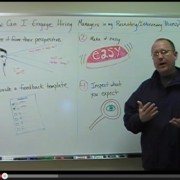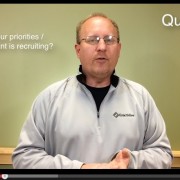Spreadsheets for Hiring | A Modern Alternative
A while back I wrote about the employee onboarding process and its movement away from spreadsheets. In that post, I shared my love for spreadsheets, but I also pointed out the shortcomings related to their use with onboarding new employees. In this post, I would like to look at another area where, in many cases, HR also relies too heavily upon spreadsheets: spreadsheets for hiring.
Spreadsheets for Hiring
Despite the rapid adoption of SaaS software by businesses across the world, the spreadsheet maintains an important role in many organizations. Most HR departments still rely on shared spreadheets for hiring and other HR processes–even those organizations that have deployed an “all-in-one” HR solution (really, all-in-one?). So all you Excel warriors out there need not fret; your skills will remain in demand and valuable….for a while at least.
The issue today is not whether organizations should ditch spreadsheets completely, it’s whether they should seek to use the best tools for the job. And spreadsheets–love them as I may–are simply not the best solution for managing the many aspects of hiring employees.
Let’s take a look at how a hiring process driven by spreadsheets stacks up against one driven by hiring software.
Tracking Your Sources
It’s important to continuously analyze what’s working and what’s not. This is true for most things in which someone wants to excel. As it relates to improving your hiring process, recruiting sources, or channels, are one of the first items an HR leader will want to analyze.
A spreadsheet can certainly help in recording and comparing the effectiveness of your recruiting channels. The difficulty arises in how you populate the data. In most cases, this will mean manually recording the data for each applicant into the spreadsheet.
Hiring software, on the other hand, will automatically pull the applicant’s source. Built-in reports and dashboards can be configured to provide you with a thorough applicant source analysis in just one click. This makes the job of source analysis so easy, that it virtually eliminates the possibility of it being overlooked.
Summarizing Applicants
All applicants are not equal. But what are the factors that reliably differentiate applicants? There is no single answer to this question, as it will vary based on role, location, and job market conditions. This makes it difficult to standardize a screening process.
Spreadsheets are best used in summarizing standardized sets of data. Standardized data is a natural product of a standardized process. So what happens when a hiring process produces highly variable data? You get an unwieldy spreadsheet or multiple spreadsheets that make analysis and comparison a nightmare.
Hiring software simplifies the task of summarizing applicants by allowing you to review applicants based on custom criteria. This eliminates confusion and facilitates efficient applicant screening and information sharing.
Rating Applicants
When it’s time to screen applicants for an open position, HR professionals will want to look at a standard set of criteria for each candidate, and then apply a rating. Often times there will be multiple people involved in this process.
Organizations that rely on spreadsheets for the rating of applicants will run into a number of obstacles when trying to record, compare, and share those ratings. Some of the more common challenges are:
- Manual data entry is often the only option.
- Multiple spreadsheets for different roles and criteria–or lots of filters.
- Complex sharing/viewing permissions or, again, multiple spreadsheets.
Contrast the above challenges with the value-added opportunities that hiring software can provide. Once again, the system will hide the messiness and confusion inherent in a spreadsheet-driven approach. Hiring software will allow for:
- Automated data entry. Data flows from the application to the database.
- Create rules to automate initial ratings based on customized criteria.
- Quickly drill down to a set of applicants you wish to compare and refine ratings.
- Invite colleagues to view limited sets of data based on predefined permission rules.
Managing The Candidate Experience
There are a number of ways to enhance the hiring experience for job seekers. One way is through personalization. Over the past decade, consumers have become accustomed to highly personalized marketing, sales, and customer service experiences. This has created the expectation of a personalized experience in almost everything–including the hiring process.
However, maintaining a personalized experience for your job applicants and candidates can be difficult. It, naturally, requires collecting a lot of personal information. But, perhaps, what’s even more challenging is the integration of personal information into your hiring workflow.
It’s likely a given by now that some of the barriers to managing a candidate experience with spreadsheets include manual data entry, role and location-based nuances, and information sharing. However there are a number of additional challenges that spreadsheets present in this scenario as well, like:
- Exporting required data to communication platforms
- Delivering reminders of incomplete internal tasks
- Managing the timing of action items against delays
It’s in addressing challenges like the ones above where hiring software really shines. Integrated communication channels allow for instant communication with applicants right from their digital file. Customized permissions ensure that all internal stakeholders have the necessary (and only the necessary) access to candidate data and statuses. Finally, task reminders can be triggered from within the system and pushed via email and text. In this way, hiring software can do more than assist with the tasks of hiring, it can elevate job seekers’ perceptions of your entire organization by ensuring that your processes are timely and seamless.
Facilitating Employee Onboarding
Too often, job seekers enjoy an impressive experience in moving from applicant, to candidate, to hired employee…only to face an abrupt and troubling reality; they’ve landed in a mess. Employers–not the seemingly friendly, competent faces of the hiring process, but the actual people and faces–are not prepared to onboard new employees in the same seamless, timely way as they hire them.
Those employers that rely on spreadsheets and deal with low-volume hiring can sometimes survive by adding more columns, adjusting viewing and sharing permissions, and maybe dipping their toes into some more advanced areas like VBA. Unfortunately, this approach still leaves an organization open to the metaphorical risks of “dropping the ball” and “letting items fall through the cracks.”
Hiring software ensures that the information initially collected through the hiring process is passed through, intact, to the appropriate onboarding forms and documents. From there, it’s a simple matter of having the new hire complete electronic signatures and check boxes for consent. There is no duplicate data entry on the part of HR personnel or the new employee.
A Modern Alternative to Spreadsheets
As I said at the top, spreadsheets aren’t going anywhere anytime soon. There is a whole generation of workers that has embraced their utility and flexibility. Furthermore, with spreadsheets, organizations don’t have to worry about whether a vendor will maintain the code and integrations, or raise prices at a later date. Spreadsheets are a safe bet.
However, for employers that find themselves in a competitive job market, any risks associated with implementing hiring software should be weighed against the risk of losing good talent and the costs of maintaining a revolving employment door. Successful employers will exercise great diligence in choosing the right vendor for their organization. With a trusted vendor in place, the risks of implementing hiring software fall away. What’s left is a modern alternative to spreadsheets that keeps the energy and focus on people and not the processes.
ExactHire provides hiring software for small and growing businesses that are seeking ways to enhance their hiring and employee onboarding experiences. We’re often the first step in helping businesses move away from spreadsheets for hiring and other HR processes. To learn more about our current and future solutions, contact us today!








